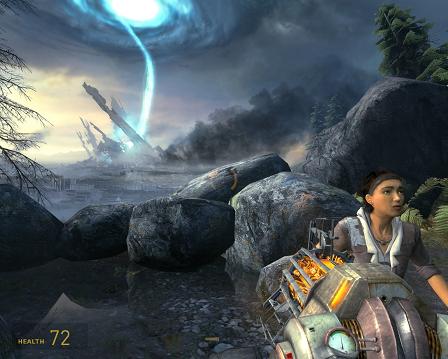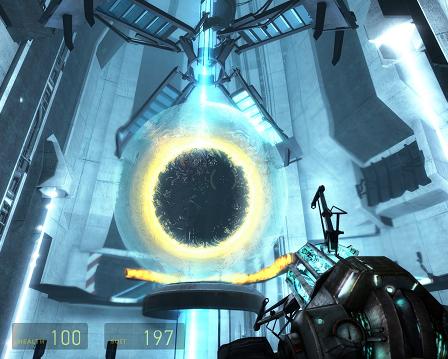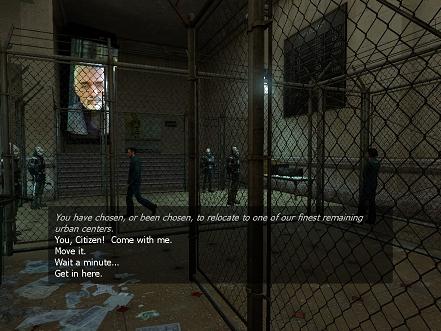
As with Episode 1, Half-Life 2: Episode 2 picks up directly where the last game left off and for the first time in the series, I found myself awed by the visuals. After you extricate yourself from the train that crashed at the end of Episode 1 and reunite with Alyx, you’re confronted with the spectacular sight of what used to be the Citadel. As you soon learn, the Combine is opening a massive superportal to call in reinforcements, and you need to head to the Resistance base at White Forest to warn them and help to shut down the portal.
Again, Alyx Vance accompanies you throughout most of the game, except for an extended sequence when a Vortigaunt fills in for her. They supply much needed commentary since as usual Gordon Freeman is conspicuous in his invisibility and silence (even from the opening cutscene that recounts the story so far such that it ends up looking like the Adventures of Alyx Vance instead). Valve’s storytelling magic is still here and the good news is that this time it’s backed up with great gameplay.
Continue reading A Game: Half-Life 2 Episode 2 →

Since even Half-life 2: Episode 1 is two years old now, it’s probably not fair to write a proper review of it so I’ll just jot down some of my thoughts on it. Its graphics are noticeably better than that of the original Half-Life 2, but still some way short of current standards. The most confusing thing about these episodic sequels is that they’re named Half-Life 2: Episode 1 and so forth, when as even Gabe Newell has said, it would make more sense to name them Half-Life 3: Episode 1 etc. Still, wholly brand new sequels are usually a lot more ambitious than Episode 1. The improvements, while noticeable, aren’t spectacular, and the way the story continues immediately after Half-Life 2 makes it feel like you’re playing new chapters of the original game rather than something completely new.
Episode 1 continues with Valve’s tradition of telling stories without cutscenes, choosing instead to keep the player in control in a tightly restricted environment to give for the NPCs to finish their canned speeches. It does work well, thanks to decent writing, good voice acting and, as before, Valve’s impressive technology of enabling the NPCs to have realistic facial expressions. But the way the game keeps locking you in rooms that can only be unlocked by an NPC after finishing a speech does get a bit too transparent.
Continue reading Half-Life 2: Episode 1 →

Half-Life 2 is a 4 year old game at this point and already a classic of the genre, so writing a conventional review of it would be pointless. But I’ve just spent the past week playing it for the first time, so I thought it would be interesting to write about my impressions on it as someone who’s played most of the current crop of modern FPS games. Technologically of course, Half-Life 2 can’t hold a candle to its successors. 4 years is after all a long time in the computer industry, and the latest graphics engines put the Source engine to shame (even the Source-engine powered Portal, new and innovative as it is, looks somewhat bland compared to current games). But overall the game still looks good enough that playing through it didn’t feel painful (unlike say, when I tried to replay Aliens vs. Predator 2 a couple of years ago) and the game’s many strengths more than made up for it.
One of my first surprises was how long the game felt compared to more recent shooters. I find that most modern shooters these days can be finished in three or four evenings of dedicated playing, but Half-Life 2 sprawling tale stretched out for the most part of a week for me and took me into a variety of locales and situations that most other shooters can’t match either. Another factor that added to its length are the storytelling sequences. Half-Life 2 has no cutscenes per se since the entire story is told strictly from Gordon Freeman’s perspective without any temporal jumps from the player’s point of view. But the story is advanced in a number of scenes which are only minimally interactive in which other characters hold lengthy dialogues with one another in Freeman’s presence. These are worth hearing alone because they show off one of the strengths of the Source engine that is still valid even today: the facial expressiveness of characters animated in the Source engine but they’re not skippable and do add to the overall length.
Continue reading A Half-Life 2 Retrospective →
The unexamined life is a life not worth living